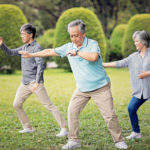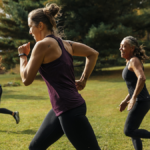
Shirley Eichenberger-Archer, JD, MA
Shirley Eichenberger-Archer, JD, MA
Article Archive
Study finds compelling reasons to start or increase a mid-life fitness program. Looking for new ways to motivate your mid-life clients? Let them know that regular physical activity during midlife may help prevent Alzheimer’s disease. A new study in Alzheimer’s & Dementia reports that increasing physical activity levels between ages 45 and 65 can slow…
Read MoreNew meta-analysis shows major benefits for clients with diabetes and obesity. A new research review confirms what many fitness pros know – resistance training delivers measurable health improvements, especially for clients who are overweight, obese or have diabetes. An international research team found that consistent strength training improved insulin sensitivity, blood glucose, blood pressure, blood…
Read MoreNew clinical trial supports myofascial release to improve movement performance. Keep using foam rollers, dynamic stretches and mobility tools to stimulate fascia. New research confirms the performance-enhancing effects of myofascial release (MFR) when added to a flexibility, muscular endurance and balance program. This single-blind randomized controlled trial studied healthy adults aged 18–35 years who followed…
Read MoreFitness pros have long understood the benefits of mind-body exercise; now, new research highlights Tai Chi as a particularly effective, non-pharmaceutical strategy that may help clients combat anxiety and stress. The study, published in Medicine & Science in Sports & Exercise suggests that Tai Chi practice alters brain functioning in ways that improve emotion regulation…
Read MoreStudy identifies mechanisms for how physical activity may prevent Alzheimer’s disease. New research reveals why exercise protects brain health. It activates specific brain cells in the hippocampus, the brain’s center for memory and learning. Scientists from Mass General Brigham and SUNY Upstate Medical University used advanced techniques to identify the brain cell types most responsive…
Read MoreStudy shows link between short between-game rest periods and increased injury risk. Here’s an important reminder for trainers who work with competitive athletes: short rest equals higher injury risk. NFL players were significantly more likely to suffer a serious knee injury—specifically tears of the knee extensor mechanism—after shorter rest periods between games, according to University…
Read MoreResearch shows connection between training timing, consistency and positive results. For older adults, regular morning physical activity may lead to better heart-lung function and walking efficiency, according to a study of about 800 older adults with an average age of 76, reported in Medicine & Science in Sports & Exercise. “While we’ve long known that…
Read MoreInternational panel defines types of stretching and evidence-based benefits. An international panel of 20 experts with both research and practical experience reached consensus on the evidence-based roles of stretching across performance and health domains. The experts noted the following benefits of stretching: In contrast to widespread assumptions, stretching does not significantly provide: These findings emphasize…
Read MoreAre you or is your fitness facility offering hybrid training offerings to your client that include online programming, fitness data and/or assessment information and in-facility live training or group exercise classes? If you are a personal trainer, have you created your own app or do you use an app-based platform to complement your training services?…
Read MoreThe battery-powered Nike x Hyperice warm-up recovery shoe and vest that use thermal and dynamic air compression technology, integrate recovery and warm-up into apparel and footwear, available globally at the holiday season. The growth in Babywearing Barre classes in studios and on YouTube where new moms strap on babies for an additional weight, posture and…
Read MoreNew study finds a relationship between aerobic exercise and vitamin D levels. Regular indoor training helps maintain healthy vitamin D levels during winter, even without supplements or fat loss, as noted in Advanced Science. With winter approaching, this adds another important evidence-backed reason to keep up an exercise program. “This is the first study to…
Read MoreNew research solves the problem of inaccurate fitness trackers for people of different sizes. Many may not realize that fitness trackers often miscalculate calorie burn for people with obesity, largely due to differences in gait, speed and energy output. To solve this problem, researchers from Northwestern University in Evanston, Illinois, created a validated, wrist-based algorithm…
Read MoreNew research recommends more individualized training guidelines. A 2025 review published in Sports Medicine challenges traditional aerobic exercise guidelines that rely on fixed percentages of peak heart rate or VO₂ max. Researchers from Hasselt University in Diepenbeek, Belgium, found that prescribing training intensity using individual thresholds such as ventilatory threshold (VT1/VT2) or lactate threshold (LT)…
Read MoreFor fitness pros who work with older adults, new research shows that exercise training can address the impact of polypharmacy (5 or more medications) that is linked with poorer functional fitness. Side effects of multiple medications include dizziness, sedation, impaired balance, confusion and delirium that can be mistaken for normal aging or even dementia. These…
Read MoreMotivate your strength training participants by sharing that higher levels of muscular strength may reduce type 2 diabetes, risks, regardless of genetics. University of Hong Kong researchers evaluated data from 141,848 white British adults in the UK Biobank, a database of over 500,000 UK adults being tracked for genetic and health information. “Individuals in middle-to-late…
Read MoreIn a move that can benefit fitness professionals, a bipartisan group of Senators and Representatives reintroduced the PHIT (Personal Health Investment Today) Act in Congress. The legislation allows Americans to use some funds in pre-tax health savings accounts and flexible spending accounts toward qualified sports and fitness purchases, such as gym memberships, fitness equipment and…
Read MoreConsistent exercise, like walking at a moderate pace for one hour a day, six days a week, is linked with improving the longevity of people who have survived colon cancer equal to the level of people who have never had cancer, according to a study published in Cancer. The study is based on data from…
Read MoreHow do you educate your clientele about the abundant health benefits of exercise? For example, are you including research bits in a newsletter? Do you maintain a resource board or offer QR links to studies? With so much evidence-based information on exercise’s role to increase the health span and improve life quality, how are you…
Read MoreIBISWORLD data projects steady growth for Personal Training (est $12.9 billion in 2024) based on a compound annual growth rate of 3.3% over the past five years; … The growing trend among Gen Z to drink less alcohol, eat healthier and to go to the gym for social benefits as noted in a UKActive analysis…
Read MoreHere’s a great evidence-based idea for a home program for clients who find it difficult to train between sessions. Eccentric bodyweight exercises, for as little as five minutes a day over a four week period, can improve physical fitness and mental health. Researchers from Edith Cowan University in Perth, Australia, enrolled 22 sedentary and healthy…
Read More














